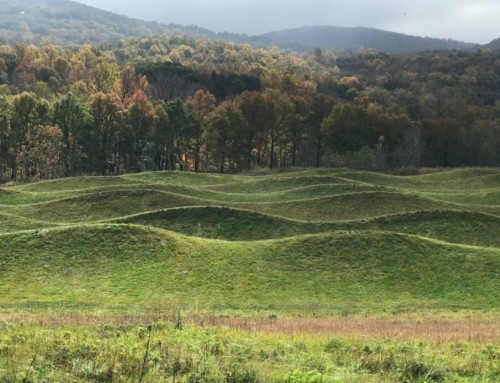I’ve never been so happy to see a big noisy machine tear apart a landscape.
My neighbors on one side bought the neglected property on the other side. He is a logger.
As he crashes through the mess of tangled vines, knocking down trees with his log skidder, the whole neighborhood cheers.
This is happy habitat destruction.
The photo above shows what happens if you don’t mow your meadow or manage invasive plants. If you “let nature take its course.”
Sure, it’s pretty in the snow. If you don’t know what you’re looking at.
Read on for the sad scenario and a photo of what it once was (and will hopefully resemble again).
Once a Meadow – Now a Mess
When I bought my house in 1989, this was a lovely meadow. I looked out on an orchard of gnarly old apple trees, grasses blowing in the wind and a row of butternuts growing along a lichen-covered stone wall.
From upstairs I could look down on wild turkey families, stalking foxes and an occasional deer scrounging for fallen apples.
Deer were shy back then, and more interested in apples than what was growing in my yard.
All winter long I watched juncos and sparrows fly feet-first into tall seed-bearing stems of native purpletop (Tridens flavus), switchgrass (Panicum virgatum) and deer-tongue panicum (P. clandestinum).
With well-calculated fluttering, they bent stems to the ground, pinned them down by standing on them and picked off seeds, one by one.
The property line is only 12′ from my house, so this view felt like part of my yard, even though I didn’t own it. Those apple trees, with so much character were cherished friends.
Over the years, the neighbors, whose house was down the hill, did less and less with this back lot.
Invasive Plants on the Move
Before I knew it, I was looking at a wall of tangled green instead of an orchard and meadow.
Hellishly fast-growing (and stinky) tree of heaven (Ailanthus altissima) reached 60′ tall, topped by multiflora rose and oriental bittersweet. Bittersweet girdled and took down all the apple trees.
Exotic bush honeysuckles, privet, barberry, garlic mustard and every other undesirable tree, shrub, vine and herbaceous ground covering plant made themselves at home.
This is the difference between invasive plants and merely aggressive ones. They’re alien and they disrupt and displace.
Apple trees and the European cool-season pasture grasses growing there are not native either. But they were polite parts of habitat that provided a living for many creatures.
It was an altered, but functioning ecosystem – until alien invaders with reproductive advantages took over.
Native Colonizers
Native plants did their thing too, additionally impacted by climate change and invasive insects. Fast-growing, prolifically seeding native ash and tulip trees quickly expressed their natural role.
After disturbance, without intervention, ecosystems in New England mostly revert to forest. Land cleared for a farm, once abandoned, turns into woods.
The ash trees, infested with invasive emerald ash borers, inundated by vines, died.
Native grapevines, growing with unprecedented vigor due to increased levels of atmospheric carbon dioxide, joined the fray.
Tulip trees (Liriodendron tulipfera) are beautiful. I love the shape of their leaves, their tulip-like creamsicle-colored flowers and the woody seed pods that rain down in fall.
They’re ancient trees, pollinated by beetles before bees came into existence – but bees love them too. Tiger swallowtail butterfly and Promethea moth larvae feed on leaves of tulip trees, their host plant.
Orioles nest in tulip trees, their woven pouches swaying from branch tips. We used to look right into one from a second-story window.
But tulip trees in my yard have dropped limbs without warning, split in storms, and they attract lightning.
Having once looked outside during a storm to see lightning strike a tulip tree and unzip 120′ of trunk, I reluctantly, prefer a little distance. They were getting too close for comfort.
Invasive Plants Don’t Observe Property Lines

Forsythia at the boundary marched into my yard despite my frequent hacking back. Birds took shelter in the unruly tangle, depositing bittersweet seeds.
The vines clambered up the forsythia into the now half-dead butternuts and jumped the gap into the top of my hemlock – where I couldn’t reach to cut it.
Deer took shelter in this mess and, since the apples were gone, made forays into my yard.
It was really depressing.
Did I have to resign myself to being shaded out? To spending even more time digging invasive plants that were already more than I could handle? To being overrun by deer?
For the rest of my life? Disheartening.
With invasive removal begun, I see tall white pines surrounding a friend’s house several skinny lots away again. I can follow the ridgeline into the distance and feel connected to the larger landscape. There’s more light.
Now what?
The plan is to return this land to orchard and meadow, as it has been since Civil War times.
The one desirable shrub – an elderberry – may be the start of a grove on our shared property line.
The ground is disturbed and bare in places now. It’s in effect tilled, prepared for all the seeds in the seedbank that we don’t want to germinate.
With permission, I’m making sure there are at least some seeds that we do want. I’ve been collecting seeds from roadside grasses – little bluestem, switchgrass and purpletop.
And if the wind direction isn’t right for my butterfly weed seeds to fly over there, I can help.
But it’s going to take an awful lot of mowing, mowing, mowing, timed right, and a good deal of hand cutting and digging to return this land to something like what it was.
It’s not my land. It’s never going to be a native plant meadow.
But my heart soars at the thought of what it can be again.






